|
|
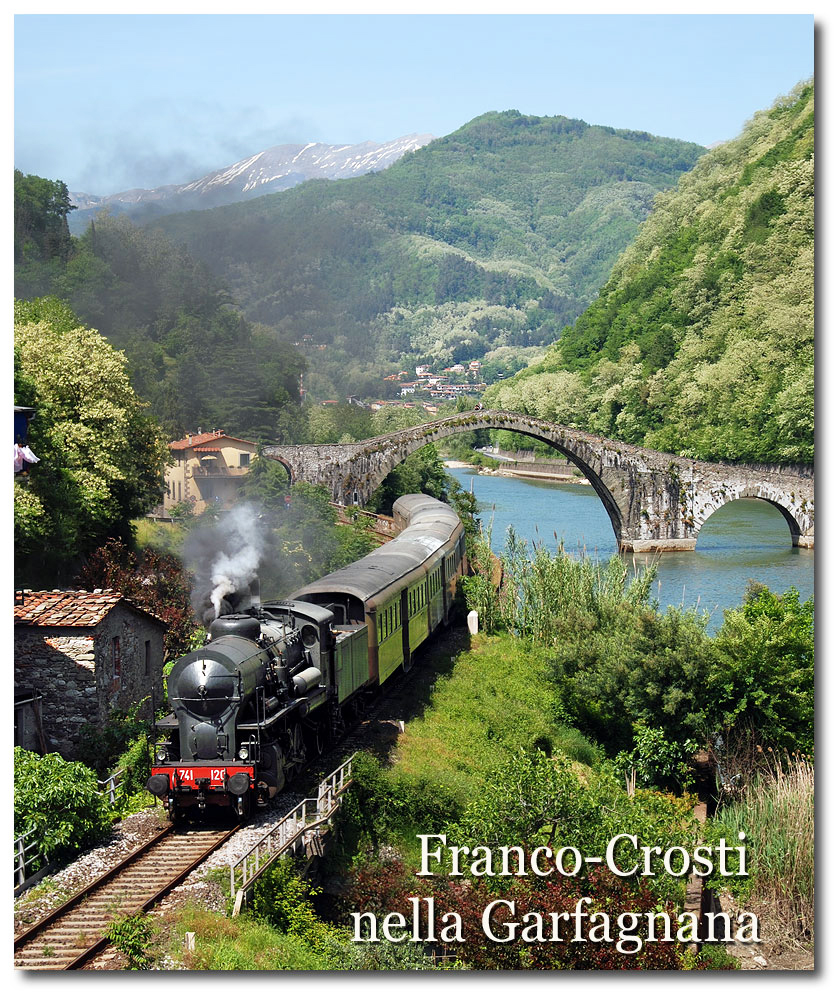 |
|
Meraviglioso
Garfagnana:
With a
passenger, 741.120 passed the 900 year old "Ponte della
Maddalena" at Borgo a Mozzano 11.May, 2009.
The
Franco-Crosti design with its feedwater heater parallel to the
boiler were an Italian invention almost as characteristic for the
country as the vespa and the pasta. Attilio Franco and Dr. Piero
Crosti, two engineers of the Italian Ferrovia dello Stato FS, began
in 1939 with modification of Gr 671. The concept was that the
preheater did warm up feeding water, thus remaining at
relatively low temperatures compared to the boiler, so the remaining
heat from combustion
gases could be
absorbed ideally. The design increased the overall efficiency
substantially.
In contrast to the Gr 623 and 743
classes built by 1940 with its massive tubes alongside the bolier
that gave the engine an odd look, the class 741 had two relatively
small preheaters only on one side and the chimmeney on the other,
which disfigured the engines far less. 81 FS 740 were fittet with
Franco-Crosti equipment between 1954 and 1960 and taken into
operation as 741. The fact that the 741 remained in service until
the very end of steam in Italy in 1978 is evidence of its successful
design.
|
|
|
|
|
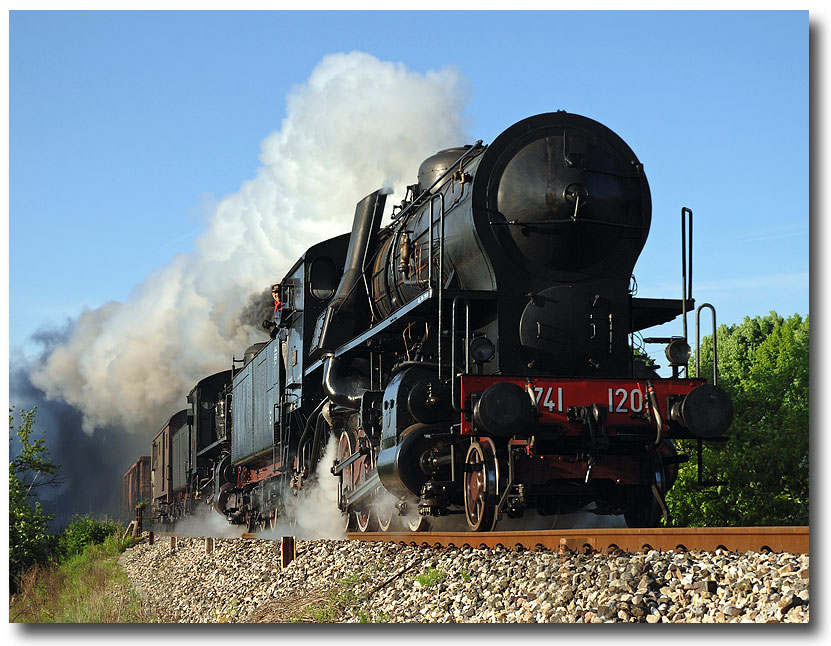
|
|
Le ore
del mattino hanno l'oro in bocca:
In
the first sunrays of a spring day, 741.120 and 740.278
storm up the valley. Ponte
a Moriano, 03.05.2008 |
|
|
|
|
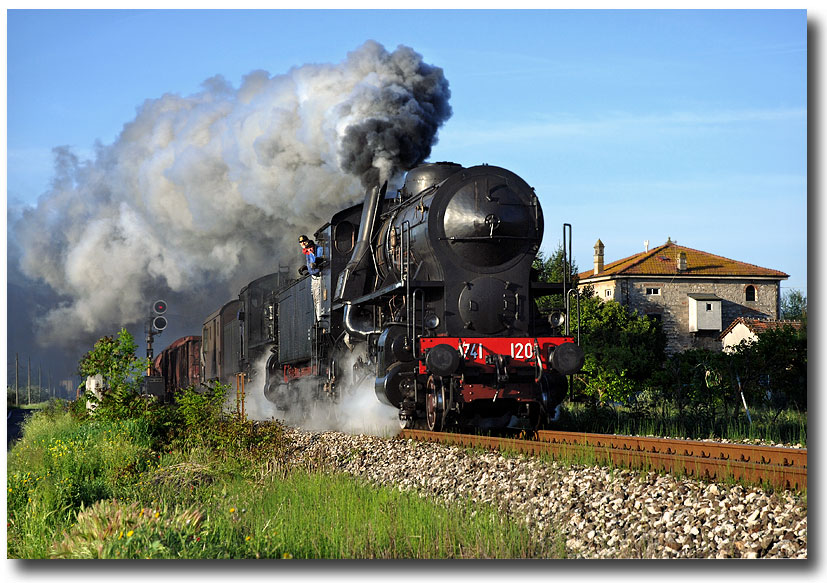 |
|
Spettacolare
doppia trazione: Near
San Pietro,
the train passes that old Tuscan manison. 03.05.2008 |
|
|
|
|
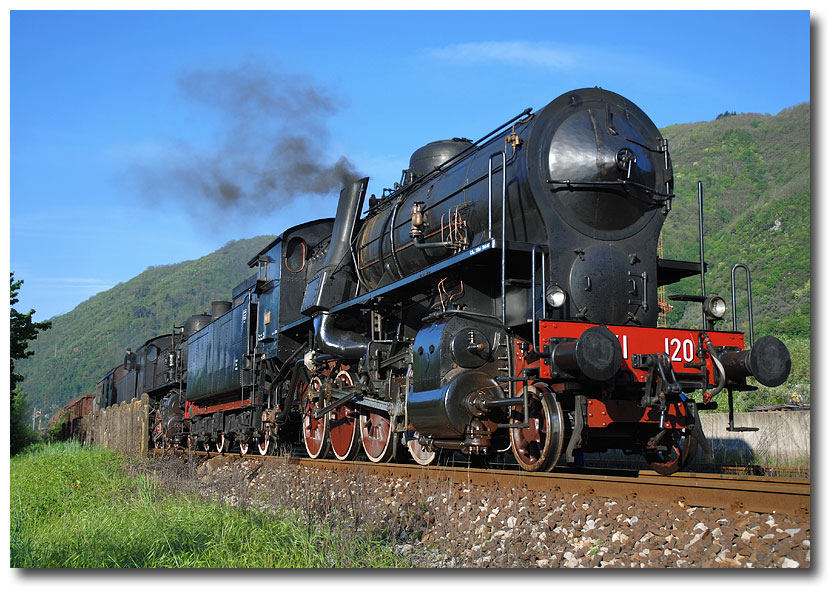 |
|
At
Diecimo,
the train awaited a crossing and an overtaking by regular some passenger
trains. Time for the crew to check and lubricate the running gear as
well as getting pressure for the coming ascent. |
|
|
|
|
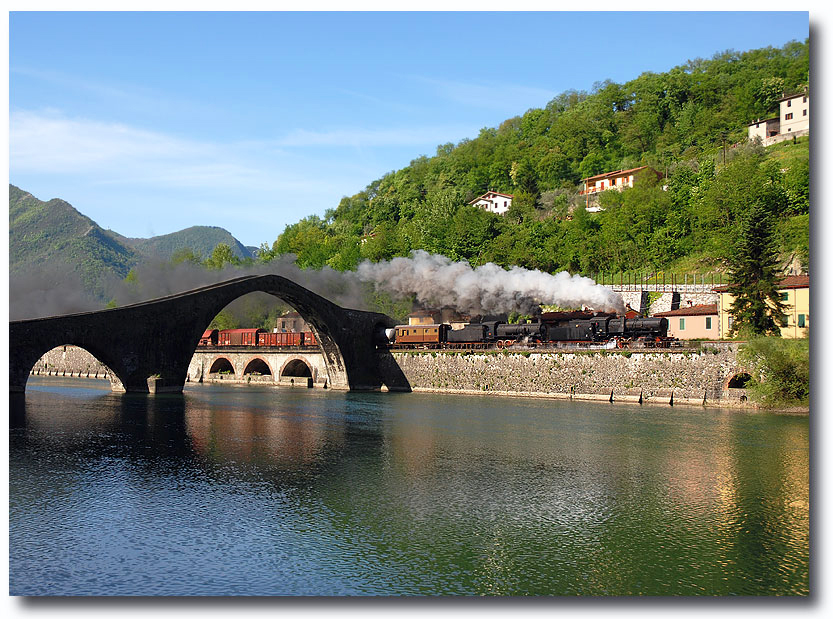 |
|
The
Ponte
della Maddalena,
originally called Ponte del Diavolo,
is a
remarkable example of medieval engineering, built in the 11th century.
It was part of the Via Francigena, a pilgrimate
road all the way from France to Rome. According to the legend, the
Devil would build the bridge for the people of Borgo a Mozzano if he
could claim the first soul to cross the bridge. When the bridge was
completed, the townsfolk sent a dog across, thwarting Satan's
plans.
Later in the 20iest century, another arch was added to allow the
railway to
pass underneath. Could the line have been integrated any better into the ancient structure?
(741 and 740, 03.05.2008) |
|
|
|
|
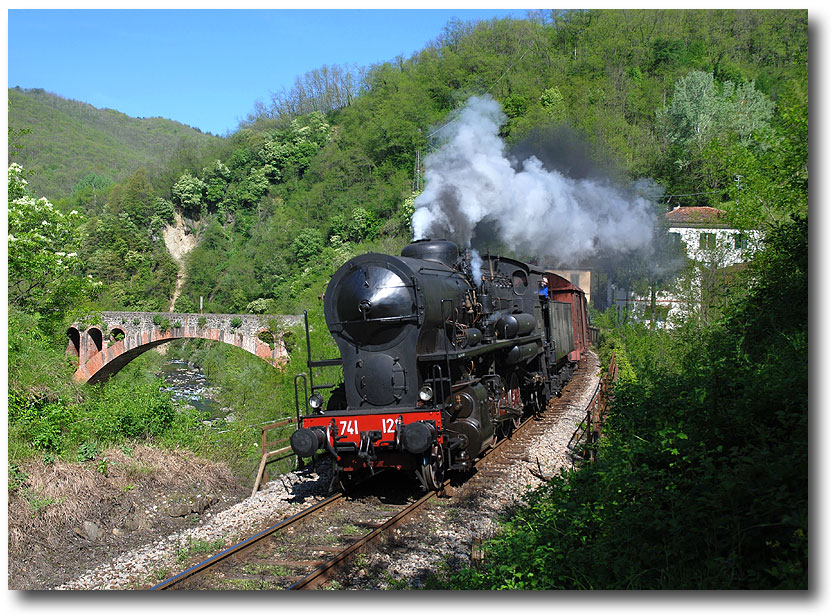
|
|
With
a downhill, Franco Crosti 741 passed this old road bridge in the
lush green Serchio river valley. Fosciandora, 04.05.2008. |
|
|
|
|
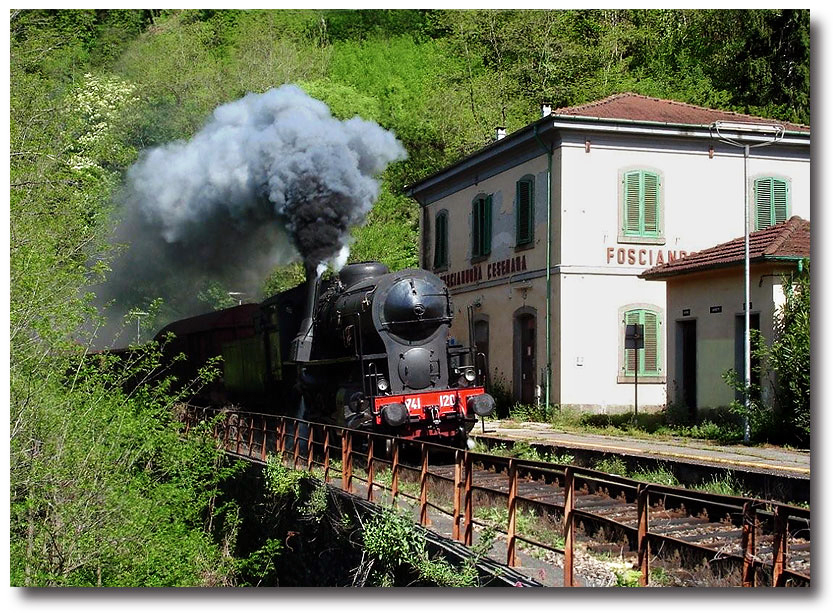 |
|
Just after a
tunnel, 741 120 stormed
past
Fosciandora station with its tipical, Italian building. Just the "Capo"
della Stazione seems to be missing here! Picture taken by Margrit Iseli,
04.05.2008
|
|
|
|
|
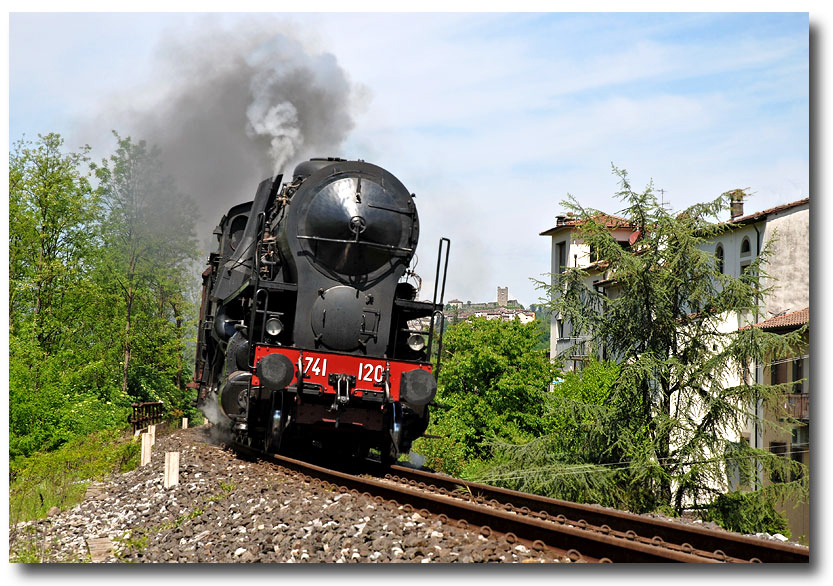
|
|
In sight of
the medieval town of Ghivizzano with its castle overlooking the
valley, 741 120 makes swift progress towards Calavorno. 04.05.2008 |
|
|
|
|
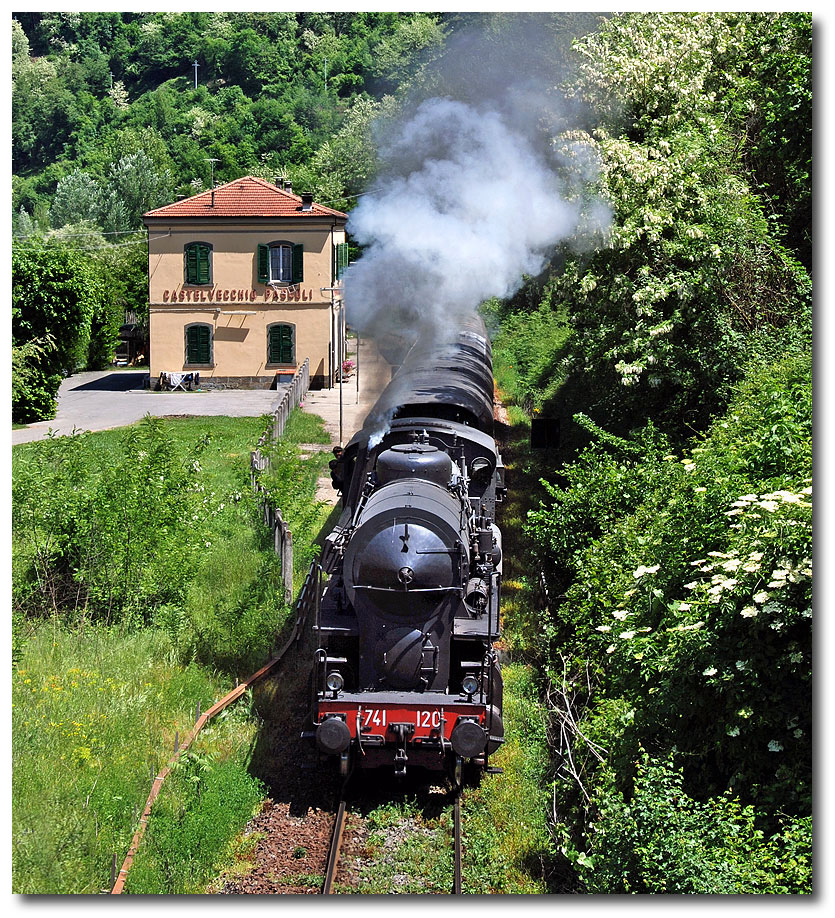 |
|
Meglio
tardi che mai - Better late than never,
we
said, when Franco-Crosti 741.120 evantually rumbled down the
Serchio valley with a hefty 3 1/2-hour-delay. The positive side was,
though, that the light had turned in the meanwhile, allowing this
shot of Franco-Crosti 741.120 accelerating at Castelvecchio.
11.May, 2009.
|
|
|
|
|
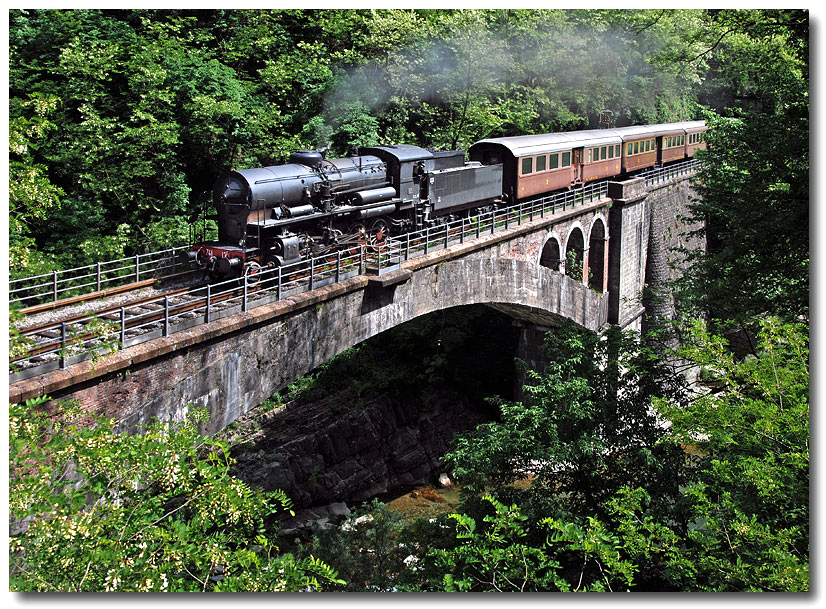 |
|
Linea
Romantica:
In the narrow Serchio valley between Fosciandora and
Castelnuovo, the line mainly goes
in tunnels, only
interrupted by a few bridges. Here, the
train had just emerged from a tunnel to disappear moments later in the
next. 10.05.2009 |
|
|
|
|
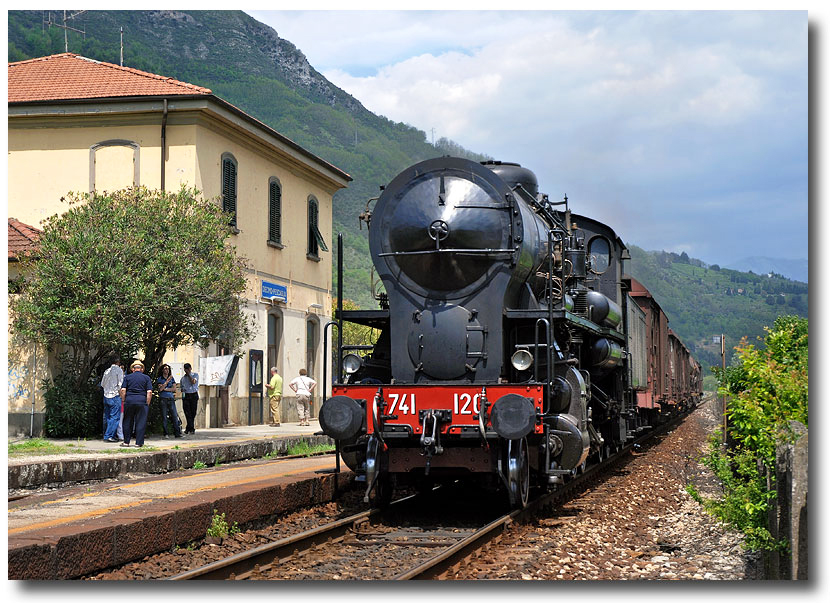 |
|
One can almost
sense the peace and tranquility of a Sunday afternoon in the Apuane
Alps.
04.05.2008 |
|
|
|
|
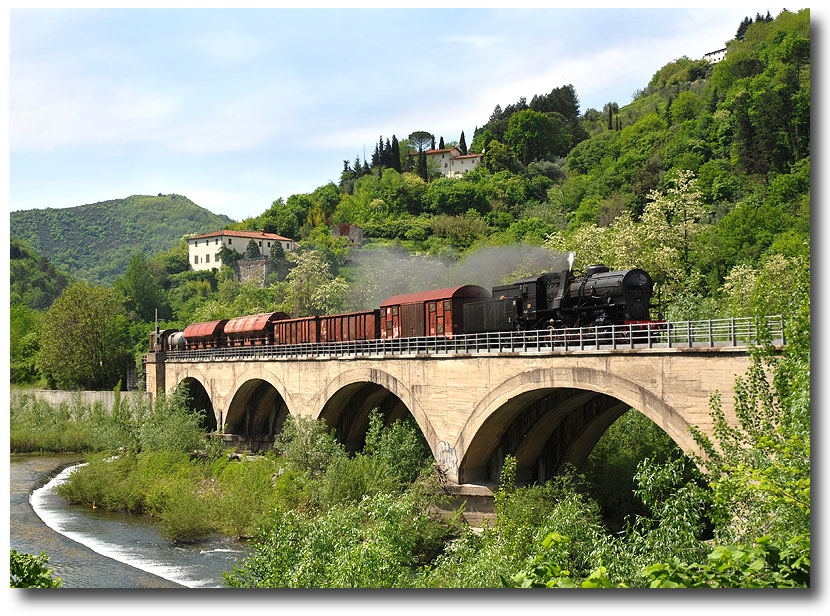 |
|
Lush green
hills and manisons of Tuscany at Ponte
a Moriano, where the line crossed the Serchio river once again.
04.05.2008
|
|
|
|
|
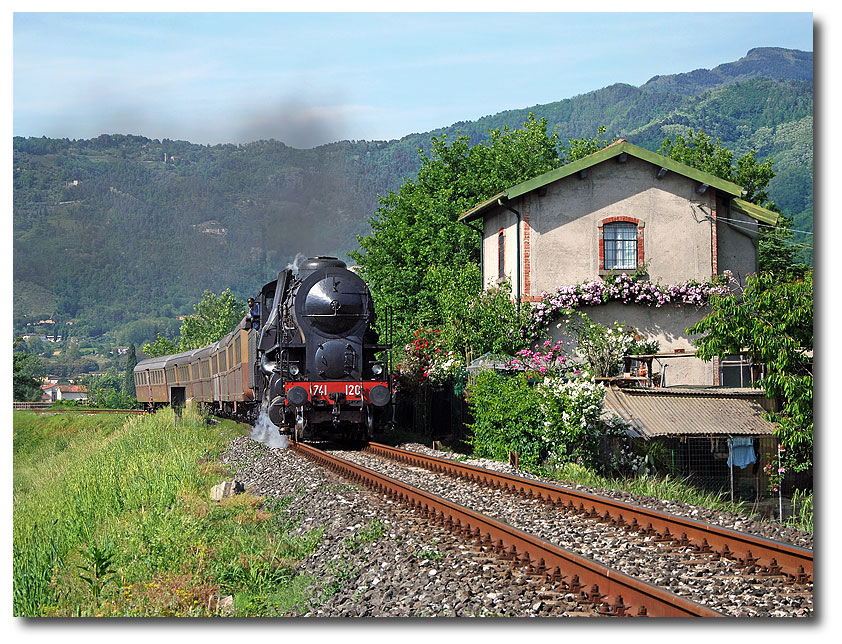 |
|
There
are always flowers for those who want to see them. At this old railwaymen's
cottage near Ponte a Moriano, the flowers could, rather than in Henri
Mantisse's proverb, hardly be overseen. Franco
Crosti Gr. 741 thrashed towards Lucca, leaving the Apennin mountains behind.
11.
05. 2009 |
|
|
|
|

|
|
There is no
shortage on Viaducts and
Bridges on the Garfagnana-Line. Here, 741.120 and 740.278
approach Camporgiano.
03.05.2008 |
|
|
|
|
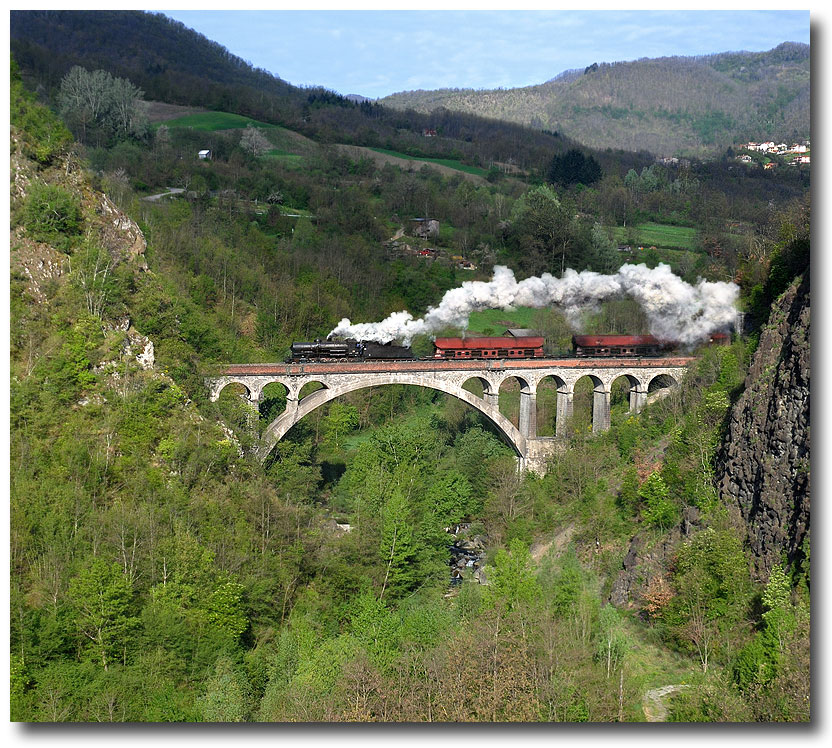 |
|
Se
non è vero, è ben trovato:
Allowedly
a bit of photoshop was required to make this shot presentable: Just when
the train pased this lovely bridge near Piazza al Serchio in the early
morning, a thick cloud obscured the sun. So what? Back home, after
some two hours of work, it was all done: Merging multiple pictures
with different exposures into one did all the
gimmick. Like
it or not, but wouldn't it have been a pity to throw away such a shot?
04.05.2008
|
|
|
|
|
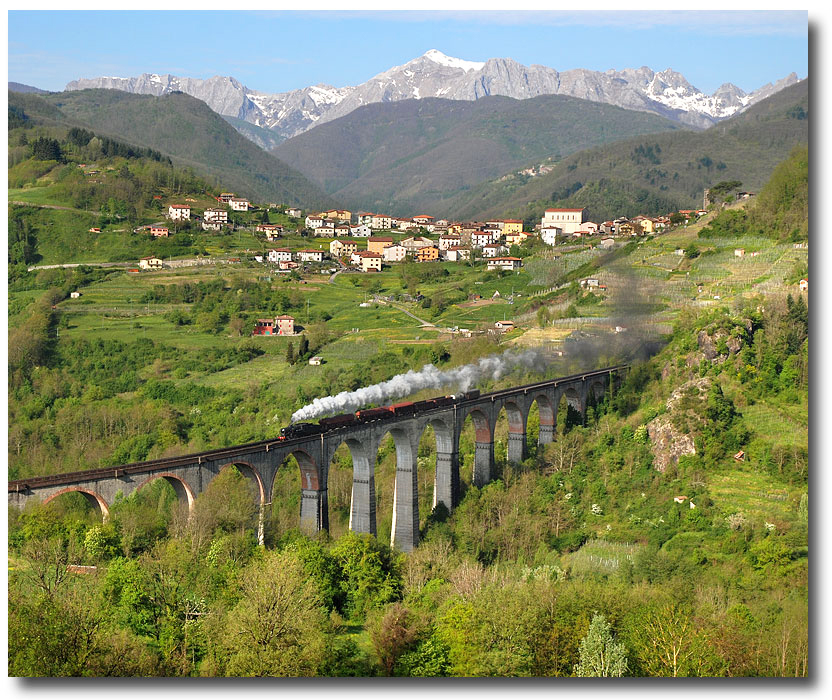 |
|
On the viaduct
at Poggio, the train would have almost been lost if it had not been
steam. With open regulator, the Franco-Crosti passed the bridge with
the majestic mountain range of the Apuane Alps in the background. Its
highest peak, Monte Pisanio, rises nearly 2000 Meters.
04.05.2008 |
|
|
|
|
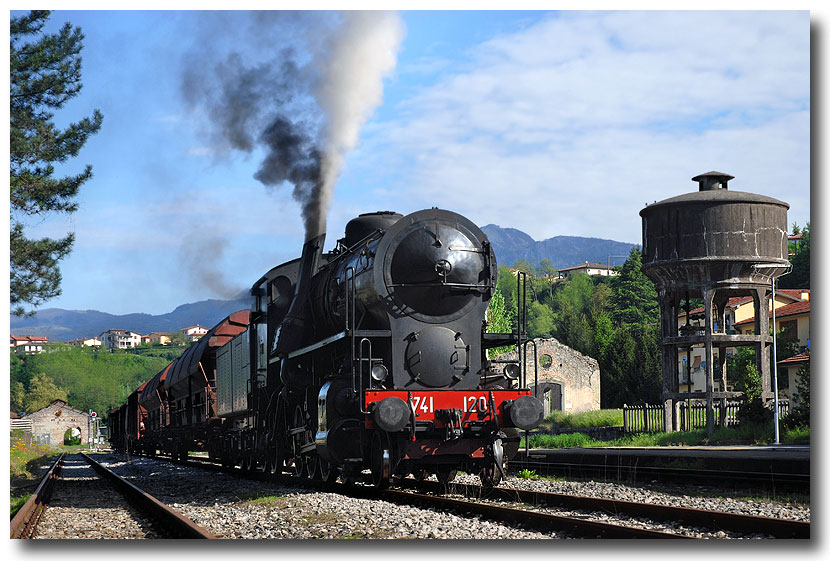 |
|
Tempi
passati: In Castelnuovo
di Garfagnana, there were some derelict remnants of the steam-era. 741
120 awaited a crossing by a regular passenger train.
04.05.2008 |
|
|
|
|
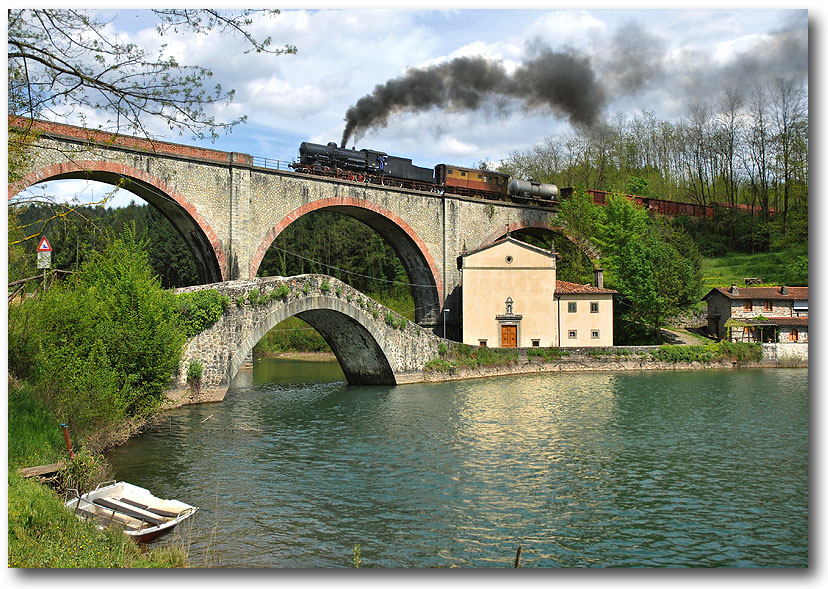
|
|
The wheezing sound of the Franco-Crosti 741
on the grade above Castelnuovo di Garfagnana could be heard long before it passed this peaceful setting at the Lago di Pontecosi. 03.05.2008 |
|
|
|
|
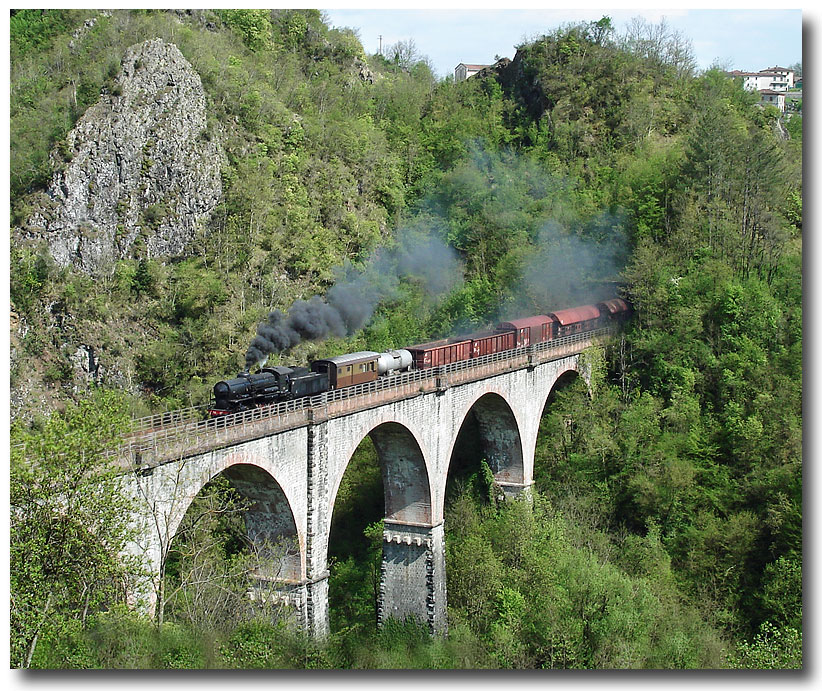 |
|
"Più
facile a dirsi che a farsi" - "Easier said then done",
was
chasing the 741 on the narrow roads of the Garfagnana, even more so,
as the Italian train crews tended to interpret
schedules their
own way and rushed through at stations they were actually meant to stop.
Still, Margrit managed to
jump out of the car and made
this pleasant shot behind
Poggio Careggine Va, while I got stuck in a traffic jam with Italians
complaining vociferous! 03.05.2008, Margrit Iseli. |
|
|
|
|
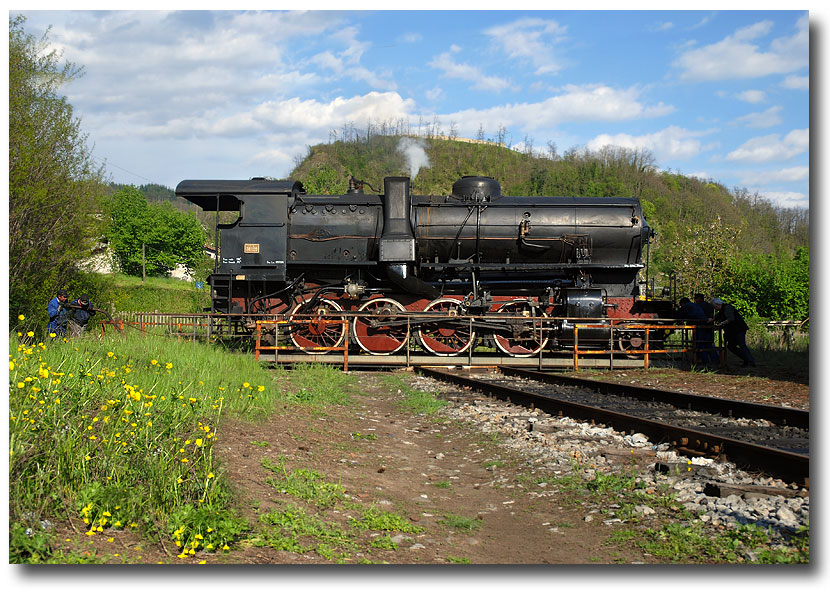 |
|
To
turn the engine in Piazza al Serchio, the tender had to be parted from
the engine, pushed manually from the turntable, then engine and tender
were
turned and coupled again. This time consuming venture was, as an
Italian peculiarity, execised in day-to-day operation until the very
end of steam at places where only small turntables
were available. 03.05.2008 |
|
|
|
|
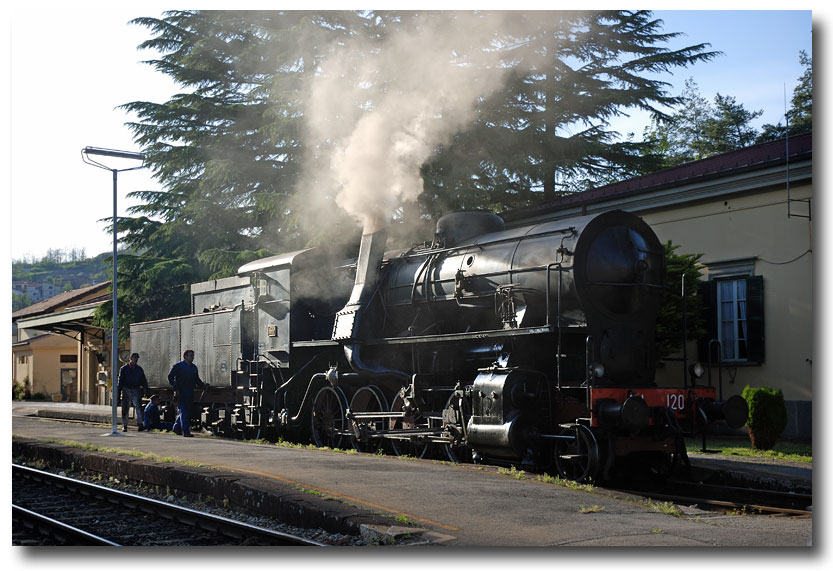 |
|
Eppur, si
muove! - Nevertheless, it moves!
Whatever
you may think about the appearance of the Franco-Crosti engines
- the design improved efficiency a great deal and allowed coal savings
of up to 20%, so it is no surprise that the 741 were among Italy's last
steam engines on the duty roster. Piazza al Serchio, 03.05.2008 |
|
|
(c) Markus Fischer, Z uerich |
|
|





